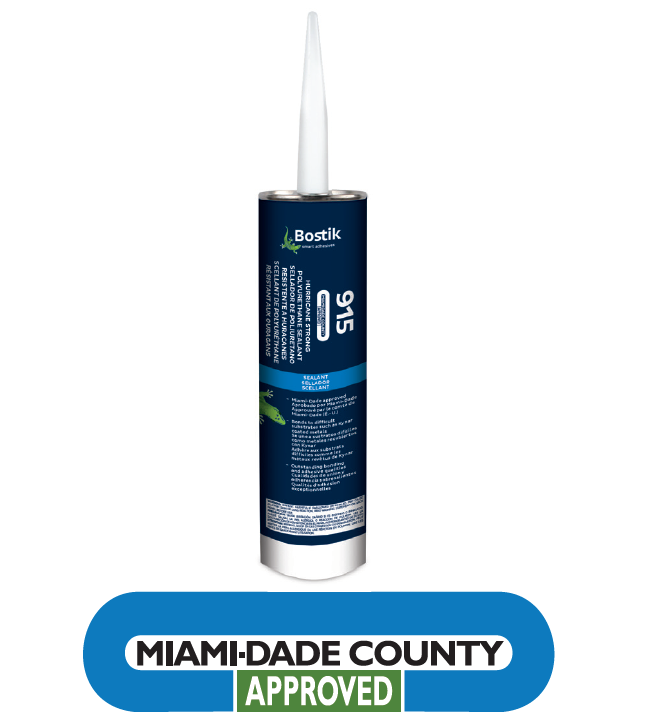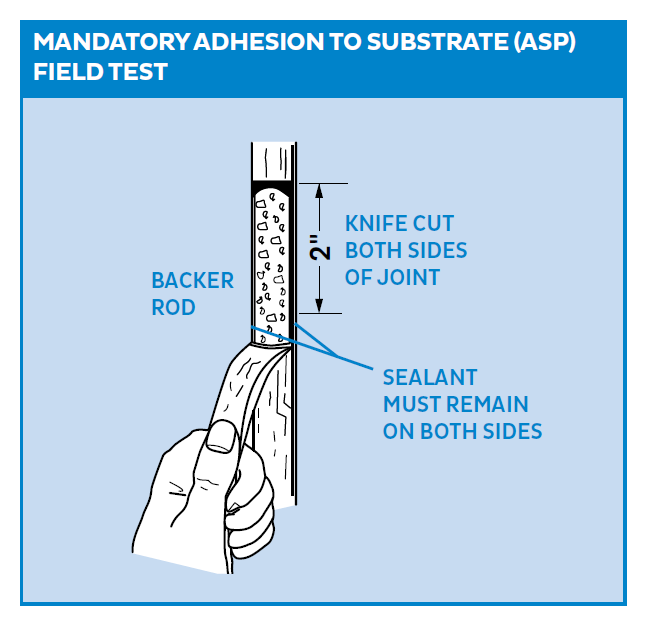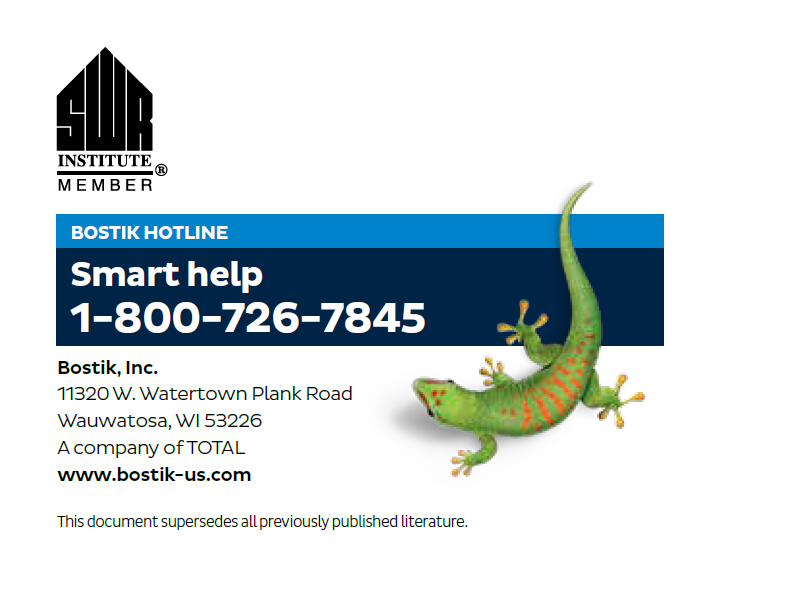
QUALITY with CONFIDENCE

– Miami-Dade approved
– Bonds to difficult substrates including most Kynar® coated metals
– Outstanding bonding and adhesive qualities
Bostik 915 sealant is a one-component, smooth polyurethane adhesive capable of dynamic joint movement totaling 70% of original joint geometry (±35%). The sealant cures to a tough, flexible rubber when exposed to moisture present in the atmosphere. Bostik 915 all seasons formula has physical properties that will remain relatively stable over time. The cured performance temperature range is -400F to 1500F. Where textured appearance is needed, please use Bostik 916 or PRO-MS 50, Textured.
ASTM C920, TYPE S, GRADE NS, CLASS 35 USE NT, A AND M
US Federal Specification TT-S 00230C (COMB-NBS) for one-component sealants as Class A, non-sag
CARB, SCAQMD, and OTC compliant
Canadian Specification CAN /CGSB 19.13-M87
Miami-Dade County, Florida, NOA No.: 13-0423.10, 05/24/17
Miami-Dade County, Florida, NOA 15-0520.01, 02/25/2021
AAMA 808.3
AAMA 100/200/300 installation requirements
Bostik 915 is designed for applications from foundation to finish and is ideal for, sealing expansion and control joints, tilt up joints, perimeters of doors, windows, and other wall penetrations. It has tenacious sealing and bonding performance for many roofing applications, metal roofs, gutters, roof tile installations, flashing and sheet metal applications.
Miami-Dade County Considerations: Mate or join adjacent surfaces prior to the Bostik 915 skinning and subsequent curing, to maximize wetting potential of the sealant to the substrates. Allow full-cure, typically 7 days, prior to any mechanical stress

testing procedures. It is recommended that adhesion testing be performed to capture batch control qualities of proposed substrates.
Joint Design: In general, more joint movement can be accommodated in a thin bead of sealant than a thick bead. Bostik 915 should be no thicker than 1/2" (12.7mm) and no thinner than 1/4" (6.4mm). In joints between 1/2" and 1", the ratio of sealant width to depth should be approximately 2:1. Sealant depth in joints between 1/4" and 1/2" should be 1/4" deep. Joints with dynamic movement should not be designed in widths less than 1/4".
Surface Preparation:See limitations about surface preparation. Surfaces must be structurally clean, dry (no frost)and structurally sound, free of contaminants, including, but not limited to, dust, dirt, loose particles, tar, asphalt, rust, mill oil, etc. If substrate is painted or coated, scrape away all loose and weakly bonded paint or coating. Any paint or coating that cannot be removed must be tested to verify adhesion of the sealant or to determine the appropriate surface preparation if needed. (See ASP section on next page for details.) To remove laitance and any other loose material, clean concrete, stone or other masonry materials with non-alcoholic based solvent by washing, grinding, sandblasting or wire
brushing as necessary. Do not use water to clean substrates. Dust must be thoroughly removed after cleaning.
Alcohol is NOT compatible with polyurethanes and its use can cause irreparable damage to the sealant. If alcohol is used as a cleaning solvent, all traces of alcohol must thoroughly be removed prior to the installation of the polyurethane sealant. Lastly, alcohol is not recommended as a tooling medium.
Backer Rods and Bond Breaker Tapes: Bond breakers including, but not limited to, closed-cell polyethylene backer rods are used to control depth of the sealant bead, provide a firm tooling surface and avoid three-sided adhesion. Where the depth of joint prevents use of backer rods, a polyethylene strip or tape must be used as a bond breaker to prevent 3-sided adhesion. Do not prime or damage the surface of the bond breaker. Refer to instructions given by rod and tape manufacturers for the correct backer rod and tape size related to joint size.
Priming: In general, application of Bostik 915 does not require priming the substrates. However, some substrates may require a Bostik primer. It is the user’s responsibility to check adhesion of the cured sealant on typical test joints at the project site before and also during application as weather conditions may affect the adhesion results (See ASP section on next page.). Refer to Bostik Primer product data sheet or call Technical Service for proper selection and application of Bostik Primers.
Tooling: Bostik 915 comes ready-to-use. Cut spout or tip to desired bead size. Apply moderate pressure to break seal inside the nozzle. Apply by using a professional caulking gun. Use opened cartridges and sausages the same day they are opened. Apply Bostik 915 in a continuous operation using positive pressure to the bottom of the joint to properly fill and seal the joint. When applying, avoid air entrapment and overlapping. Tool the sealant before the skin forms with adequate pressure to spread the sealant against the backup material at the bottom and sides of the joint. A dry tool with a concave profile is recommended for that operation. Do not use water or soapy water for this operation. Avoid smearing and feathering of the sealant to allow full performance of the cured seam. Excess sealant should be dry-wiped or joints should be properly taped.
Cleaning: After dry-wiping uncured sealant from substrates and tools, remaining uncured sealant can be removed by using Xylene, Toluene or similar aromatic solvents. Please refer to the SDS’ provided for these solvents before use. Bostik Hand Towel and Specialty Sealant Remover can also remove uncured sealant. Cured sealant is usually very difficult to remove without altering or damaging the surface to which the sealant has been misapplied. Cured sealant can be removed by abrasion or other mechanical means (scrapers, putty knives).
Curing Time: Bostik 915 is a moisture cure, Polyurethane Sealant. On wood, with ambient air at 50% relative humidity and at 73°F, polyurethane sealants will generally skin within four hours and cure 1/16 of an inch per day. Lower temperature and lower relative humidity will significantly increase the skin time and cure time of a polyurethane sealant.
Painting and Coating: Bostik 915 is not an RTV silicone and therefore is suitable for painting with latex-based paints. Paint chemistries and flexibility characteristics of the paint films over the sealant may affect wetting, adhesion and integrity of the paint layer, and it is therefore mandatory to pretest the paint or other coating over the Bostik 915 to ensure the successful compatibility between the sealant and the paint/
coating after a sufficient amount of time. See your paint manufacturer for specifications or limitations and call our Technical Service for more information. In general, oil-based paints are not recommended because of their poor elastic properties and because of their potential interaction with the sealant chemistry, which may create non-curing conditions for the painted sealant. Do not paint over the polyurethane sealant until it has fully cured.
Maintenance: If the sealant becomes damaged, replace the damaged portion by removing the old sealant completely, cleaning the surfaces and reapplying a fresh and appropriate amount of new sealant in accordance with the directions and information contained in this data sheet.
A hand pull test must be run before the job starts and at regular intervals during the job. It must be run on the job site after the sealant is fully cured, usually within 7 to 21 days. (Adhesion may develop fully after at least 14 days.) The hand pull test procedure is as follows:
Make a knife cut horizontally from one side of the joint to the other.
Make two vertical cuts approximately two inches long, at the sides of the joint, meeting the horizontal cut at the top of the two-inch cuts.
Grasp the two-inch piece of sealant firmly between the fingers and pull down at a 90° angle or more, and try to pull the uncut sealant out of the joint.
If adhesion is sufficient, the sealant should tear cohesively in itself.
Sealant may be replaced by applying more sealant in the same manner as it was originally applied. Care should be taken to ensure that the new sealant is in contact with the original, and that the original sealant surfaces are clean, so that a proper bond between the new and old sealant will be obtained.
10.1 fl. oz. Cartridges, 24 Cartridges/Case
20 fl. oz. Sausages, 12 Sausages/Case
5 Gallon Pails
52 Gallon Drums
Shelf life of Bostik 915 must be checked prior to using the product; do not use past its shelf life. Caulk past its shelf life may not perform or adhere as described by this data sheet. High temperature and high relative humidity may reduce significantly the shelf life of polyurethane sealants. If you are unsure of the expiration date of your Bostik product, please call customer service at 1-800-7/BOSTIK (1-800-726-7845) to check if the product is still within its shelf life.
White Stone Bronze Tan
Black Limestone Md. Bronze Light Gray
Terra Cotta Aluminum Stone
Available from authorized Bostik distributors. Go to www.bostik-us.com and check on our distributor locator for the closest distributor in your location or call customer service at 1-800-7/BOSTIK (1-800-726-7845).
HARMFUL IF SWALLOWED OR INHALED. CONTAINS POTENTIAL SENSITIZER. MAY CAUSE ALLERGIC SKIN OR LUNG REACTION. MAY IRRITATE EYES, SKIN AND RESPIRATORY TRACT. Methanol may form during curing. Do not breathe fumes. Do not get in eyes, on skin or on clothing. Use with adequate ventilation or wear mask. Wash thoroughly after handling. Store container in a cool, dry area with lid tightly sealed. Do not reuse container. KEEP OUT OF THE REACH OF CHILDREN
Construction substrates have become complex and diverse by nature and origin. Substrate chemistries and structures can interfere with adhesive performances of the sealant. Adhesion to Substrate Pretest (ASP) is therefore MANDATORY to assess any adhesion and sealing characteristics — see Adhesion to Substrates Pretest section and see Installation Protocol section. This must be done pre-installation to avoid potential failures. Call Technical Service for more information about surface preparation and possible priming.
Do not apply over damp, contaminated, loose surfaces (See Installation Protocol and Surface Preparation), old sealants or other foreign substances that may impair the adhesion bond. Avoid air entrapment.
Dampness and substrates with high moisture content will trigger extensive curing of the sealant within a very short period of time. This may cause an excess of bubbling and foaming within the sealant and at the bottom of the bead.
High temperature/humidity can cause the sealant to develop bubbles during the curing process.
Sealant installation is not recommended when the dew point of the substrate is close to ambient temperature or a moisture-vapor transmission condition is present increasing the potential for bubbling to form during cure.
Porous substrates such as, but not limited to, marble, limestone, and granite might absorb components of the Bostik 915 leading to staining of the substrate. ASP with sufficient aging is mandatory to assess this potential issue.
The ultimate performance of Bostik 915 depends on proper joint design and proper application with joint surfaces properly prepared (See Installation Protocol). Bostik 915 is not recommended for joints with dimensions less than or greater than what is recommended below. (See Installation Protocol — Joint Design section.)
Bostik 915 must not be used to seal narrow joints, fillet joints and face nail holes.
Smearing and feathering Bostik 915 over joints is not recommended.
Bostik 915 is not recommended for horizontal joints or traffic-bearing joints where abrasion resistance is required (walkways, driveways, runways, etc.). Please refer to Bostik 955-SL for this application.
Bostik 915 is not recommended for continuous immersion in water or any other fluid. When fully cured, avoid exposure, even incidental, to fuels, chlorinated, acid and alkaline solutions. Bostik 915 is not recommended for exterior or interior sealing below the waterline; please refer to Bostik 940 Fast Set for marine applications.
Contact of Bostik 915 with asphalts (i.e., back coating of window flashing, etc.) and other filler compounds impregnated with oil, asphalt, tar, etc., may deteriorate the cohesive strength of the substrate and ultimately compromise the seal. Please refer to PRO MS 50 for asphalt applications.

During the curing of Bostik 915, do not expose to curing silicone sealants, curing Bostik PRO-MS 50,Bostik 2000 or Bostik 2020, alcohol, acids or solvent-based materials.
Compatibility to copper-based substrates (i.e., flashing) can vary due to, but not limited to, age and joint size. Please consult Technical Service for details.
Lower relative humidity and temperature will significantly extend the curing time. Confined areas, deep joints and moisture barrier substrates may also affect the full cure time and extend it by many days. Apply sealant in ambient air temperature of 40° F (4.4°C). and rising.
Bostik 915 may remain tacky for a few hours and attract dust and dirt from the jobsite which may affect the appearance of the sealant. Check tack-free time to prevent dirt pickup.
Bostik 915 is not recommended for glazing applications. Bond line strength can be affected by UV rays through the clear material (glass, acrylic glass, polycarbonate, etc.).
Bostik 915 is not an RTV silicone and therefore is suitable for painting with latex based paints. Paint chemistries and flexibility characteristics of the paint films over the sealant may affect wetting, adhesion and integrity of the paint layer; and it is therefore mandatory to pretest the paint or other coating over the Bostik 915 to ensure the successful compatibility between the sealant and the paint/coating after a sufficient amount of time. See your paint manufacturer for specifications or limitations and call our Technical Service for more information. In general, oilbased paints are not recommended because of their poor elastic properties and because of their potential interaction with the sealant chemistry, which may create non-curing conditions for the sealant. Do not paint over the polyurethane sealant until it has fully cured.
The surface of a Bostik 915 seal when exposed to UV rays and sunlight will yellow and will not retain its gloss. This phenomenon can occur within a few weeks after exposure. The change of color is limited to the surface layer of the seal and should not compromise the sealing properties of the Bostik 915 if the dimensions of the joint are proper and the sealant is otherwise properly applied. In areas where color retention is critical, please refer to Bostik 2000, Bostik 2020 and Bostik PRO MS 50. Bostik 915 may remain tacky for a few hours and attract dust and dirtfrom the jobsite which may affect the appearance of the sealant.
Check tack-free time to prevent dirt pickup.

The Limited Warranty for this product can be found at www.bostik-us.com/resource-center/warranties or by calling 1-800-726-7845 (choose option 2, then option 2 again). TO THE MAXIMUM EXTENT ALLOWED BY LAW, BOSTIK DISCLAIMS ALL OTHER EXPRESS OR IMPLIED WARRANTIES, INCLUDING WITHOUT LIMITATION WARRANTIES OF MERCHANTABILITY AND FITNESS FOR A PARTICULAR PURPOSE. UNLESS OTHERWISE STATED IN THE LIMITED WARRANTY, THE SOLE REMEDY FOR BREACH OF WARRANTY IS REPLACEMENT OF THE PRODUCT OR REFUND OF THE BUYER’S PURCHASE PRICE. BOSTIK DISCLAIMS ANY LIABILITY FOR DIRECT, INCIDENTAL, CONSEQUENTIAL, OR SPECIAL DAMAGES TO THE MAXIMUM EXTENT ALLOWED BY LAW. DISCLAIMERS OF IMPLIED WARRANTIES MAY NOT BE APPLICABLE TO CERTAIN CLASSES OF BUYERS AND SOME STATES DO NOT ALLOW THE EXCLUSION OR LIMITATION OF INCIDENTAL OR CONSEQUENTIAL DAMAGES, SO THE ABOVE LIMITATIONS MAY NOT APPLY TO YOU. It is the buyer’s obligation to test the suitability of the product for an intended use prior to using it. The Limited Warranty extends only to the original purchaser and is not transferable or assignable. Any claim for a defective product must be filed within 30 days of discovery of a problem, and must be submitted with written proof of purchase.

